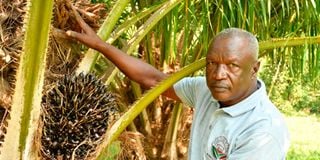Retired teacher profits from palm oil value addition

Victor Otieno is a palm tree farmer from Siaya County.
What you need to know:
- Harvesting of oil palms usually begins 2.5 years after the trees are planted in the field.
- Harvesting takes place throughout the year, usually at 2-3 week intervals as the bunches ripen.
A few years ago, Victor Otieno Maura, a retired teacher, planted palm trees on his farm. Now he is reaping the benefits.
The 20 palm trees scattered around his farm in Sigomere, Siaya County, not only add beauty to his home, but also serve as an alternative source of income.
In April 2016, Otieno bought 20 palm oil seedlings from KALRO Alupe in Busia at Sh200 each. He planted the seedlings at a distance of 9m by 9m. The recommended minimum spacing is 7.8m.
"I used mixed compost and soil for propagation. Palm oil trees do well in sunny weather with annual rainfall of 1,000-1,500mm," said the 65-year-old farmer who retired 10 years ago.
Harvesting of oil palms usually begins 2.5 years after the trees are planted in the field.
When the fruit on the oil palm tree turns a bright red-orange colour, it means it's ripe and ready to be harvested.
Depending on the maturity of the tree and good propagation, a bunch of palm fruit can weigh between 5kg and 30kg.
When the bunches are harvested, the palm leaves are usually cut off.
Harvesting takes place throughout the year, usually at 2-3 week intervals as the bunches ripen. The bunches are harvested by cutting them from the tree with a sharp sickle.
Otieno has been farming palm trees for eight years.
In 2022, after receiving training from KALRO on value addition, Otieno decided to start processing the crude oil.
When we visited his farm, he was processing the oil from the harvested palm fruits. The process is tedious and he uses firewood to extract it.
Once the palm fruits are harvested, he leaves them to ferment for a day. To extract the crude oil, the palm fruits are washed and boiled for 30 minutes until the husk is tender.

"Once it is soft, I drain the water and transfer the boiled palm fruits into a mortar. The pounding is done until the husk comes off," explained Otieno.
He then scoops out the pounded fruit and transfers it to a trough or sufuria.
"Then I pour hot water into the crushed palm fruit. Then I gently squeeze the palm juice out of the seeds. We sieve the juice ready for further boiling," he said.
"I boil the juice in the pot until the water evaporates. What is left in the pot is the red palm oil.
The red palm oil is packaged in 500ml and 1 litre bottles that sell for Sh500 and Sh1,000, respectively.
"Most of the customers who buy the crude oil come from Kisumu, Nairobi, Nyeri and Siaya. Those who have realised the health benefits of the oil are not afraid to order it," he said.
He also has a small greenhouse in the compound where he produces the palm seedlings.
Seed treatment is important for proper germination. If the seeds are not properly prepared, they will germinate after a few years due to long dormancy.
"We dry the seeds for about 2.5 months in stable hot rooms (40°C) and soak them for 4-5 days in water that is changed daily. This way the seeds will germinate in about 12 days," he explained.
Immediately after germination, the seeds are planted in polythene bags or containers with an equal mix of topsoil, sand and well-decomposed cattle manure.
Cultivated sprouts remain in the bags for about 4-5 months (until they develop a bifid leaf).
Sprouts with bifid leaves are then transferred to a plantation nursery where they continue to grow for about a year.

Victor Otieno displays crude red oil extracted from palm oil.
Finally, seedlings with about 12 to 15 leaves and at least one metre in height are mature enough and ready to be grown on palm oil plantations. He currently has 800 seedlings on his farm, each costing Sh500.
In a good month he makes a sale of Sh50,000 for both the palm oil and the seedlings.
Currently, Homa Bay is positioning itself as one of the counties in the Lake Region bloc to produce crude oil.
Otieno said the crude oil can be used to produce refined oil, margarine and soap. The oil is used in baking biscuits, crackers and cakes.
"Palm kernel oil is used in the cosmetics industry to make oil for hair and skin products," he said.
Despite having a favourable environment for growing palm oil trees, Kenya imports most of its crude palm oil from Malaysia.
"If only farmers in Kenya were patient and embraced the venture of palm oil farming, we would not be experiencing the high prices of oil," he said.





